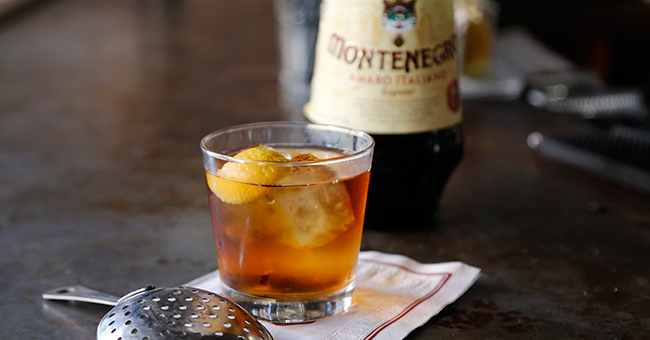Many Italian amaro brands have been commercially available in Italy, offered as a pungent, bitter digestif and aperitif, since the 19th century, but its roots trace back to ancient history. In the States, it’s become a key component in cocktails.
Its versatility and usefulness are largely due to two things: depth of flavor and breadth of category. Not all Fernets are Branca. Amari can be spice-forward, like Cardamaro or Meletti. Cynar, which rounds out cocktails from Dan Greenbaum’s aptly acerbic Remember the Alimony to the Kuala Lumpur Hilton’s lush and juicy Jungle Bird, avails itself of artichoke’s bitter elements. Branca Menta is a powerhouse of mint.
From New York City’s Amor y Amargo to Chicago’s Balena and Billy Sunday to Santa Monica’s Copa D’Oro, amaro is out of the bottle and capturing yet more attention among neophytes and aficionados alike.
Keith Whitten, Balena’s beverage director, has been serving amaro since the restaurant opened its doors, four years ago. “We have opportunities,” Whitten, “to put [amaro] in front of people for the first time.” While Whitten owns the fact that cocktail aficionados know of amaro as a category, the general public is “not accustomed to the flavors, the richness of the palate, the bitterness, the flavors that amaro delivers.”
Although Balena features amari on the dessert menu, as a digestif, “our specialty cocktail program was based around amaro.” At any time, there are fifteen to twenty amari on the menu.
Whitten has something in common with most cocktail hounds. The first amaro that made an impression on him was Fernet Branca. “Six years ago, even before I started working at Balena, it was something people in Chicago would pour you as a shot, to welcome you into their company.”
The next amaro Whitten mentions is completely different. “Amaro Nonino is absolutely lovely … lighter in color, really smooth on the palate, more flavors to it.”
For a drinker seeking something robust and bitter, Whitten says Santa Maria al Monte “is a fun one. It originated in Genoa, in the late 1800s, that area being somewhat of a crossroads for amaro production, because of the Asian spice trade coming into the Port of Genoa.” Put exotic Asian spices, French Alpine herbs, and 19th-century Genovese ingenuity together, and a unique amaro is almost bound to happen.
Whitten grins. “That’s the fascinating part about this: all sorts of cultural and economic and political histories becoming something that ends up in your glass at the end of a meal.”
Most amari are Italian born and bred, but, Whitten says, “there’s a lot of domestic producers getting involved.” Is that a benefit to or a blight on the category? “I think it’s a good thing. It takes a little bit of attention away from the traditional Italian products.” By and large, Whitten doesn’t find the New World amari as richly flavored or storied as the Old, but his mind isn’t closed to possibilities. From a hospitality perspective, however, “telling the story of a local distiller who just opened up and discovered this thing that excited them, and they decided to make it – It’s certainly a palate-opener.”
Homegrown amari production is on the rise, bringing diversity with it. BroVo, in Seattle, sails three flagship amari. Fernet Leopold Highland Amaro sounds European, but it’s steeped in Chicago; Leopold’s mint is countered by flowers including roses, elderflowers and honeysuckle. Down in NOLA, Bittermen’s takes one of amaro’s most consistent and bitter components – gentian– and puts French yellow gentian root at the heart of its Amère Sauvage. Subtle and supple, Breckenridge Bitter is all about mountain herbs. Fittingly, it comes from Colorado. There are more: CH Amaro, Leatherbee Fernet, Don Ciccio & Figli Amaro Delle Sirene, and the list gets longer all the time.
While American amari are as diverse in taste, texture and story as their Old World counterparts, from a bartender’s perspective, they have one distinct advantage: they’re built to play well in cocktails. Although you can’t take them for granted (don’t randomly grab a bottle of Balsam or Amer dit Picon and swap it for a recipe’s Fernet Branca or Cynar), you should taste them, play with them, and put them to work. If they make brilliant cocktails, come with good travelogues or talk-worthy herbs, and turn newcomers into regulars, then that’s not surprising. Many U.S. amari are produced by former bartenders, who bring a sense of the game to the bottle.
Returning to Italy, Whitten says, “I’m a big fan of Amaro Montenegro. It’s a floral, perfumed amaro that has a little bit of bitterness … something you could offer a first-time amaro drinker that’s not going to put them off too … It’s just really, really pretty.”
With that, Whitten launches off into the romantic of Amaro Montenegro, which was developed for the 19th century wedding of a princess. In that context, the amaro’s garden of aromatics makes satisfying sense. Once upon a time, there was an amaro…
Amaro is a broad category containing other categories that are broader than the average drinker might imagine. Here are a few:
1. Artichokes, mushrooms and more
Vegetable loves: Carciufo is made with artichokes; Cynar, bright red and bitter, is the most familiar – but it isn’t as simple as it seems; thirteen herbs contribute complexity. Tartufo is made with black truffles. Look for Tilius Amaro al Tartufo, Amaro al Tartufo Nero di Norcia, and Amaro al Tartufo Nero di Norcina. It makes a lush after-dinner pour, and adds savory, earthy notes to cocktails. Zucca is made with rhubarb and strays toward the sweeter end of the spectrum.
2. Mountain air in a bottle
Alpine amari are strongly influenced by Alpine herbs. This harkens the day when local was normal, but there was enough trade to allow for innovation. Campari’s bitter, incense-deep Braulio has a cool, crisp hit of mint.
3. Vermouth (Yes, Virginia, vermouths are amari.)
Where an amaro is based in grain, vermouths are made with wine (and, per EU regulations, wormwood), which makes for a different weight, intensity and counterpoint to the bitter herbs and roots. When you have a bitter-loving patron seeking an unusual low-alcohol cocktail, you’ll be glad to have these on hand. European imbibers can try Cocchi Vermouth Amaro Dopo Teatro or Diesus Amaro del Frate. Some of Uncouth Vermouth’s seasonal, hand-foraged offerings have enough bitterness to earn them amaro status. It’s worth calling to find out what’s available, what’s fitting and what’s steeping in the back room. When you taste it, have it straight. Then try it with ice. Next, go for a splash of soda, adding fizz to amaro’s digestive properties. After that, you’ll be ready to recommend or blend.
4. Floral, fruity Fernet Leopold
Compared with Branca, Leopold Brothers’ herbaceous Fernet Leopold Highland Amaro is fruity and unctuous. Like the distillery’s fernet, it’s aged in Chardonnay barrels. When it comes to mixing, the floral elements – lavender, elderflower, rose, and honeysuckle on the nose – make it a nice fit for spring and summer cocktail menus, but ample bitterness to keep things … interesting. Unsurprisingly, given the name, it plays well with highland whiskies, but give it a go with gin, with its full suit of botanicals.
5. Dark, dense Fernet-Vallet
South of the border, Fernet-Vallet has been in production since the 1860s. Staying power isn’t just in the still. Fernet-Vallet’s Aperitivo-Liquer is dark and dense with quassia bark, gentian root, cardamom, and cinnamon. Don’t pour this for neophytes; this is as bitter as it gets. That does, however, make Aperitivo-Liqueur great a sub-and-swap approach to tweaking cocktails.
6. Assertive, Ango bark-based Amargo-Vallet
Amargo-Vallet Bark of Angostura Aperitivo-Liqueur eases back on the bitterness – at first taste. Amargo-Vallet’s macerated cherries mask the bitterness; then, that ango note pierces the fruit. There’s less mint and more dark-roasted coffee in this 90 proof spirit. Try it as a surrogate for bitters.
7. Old World-inspired, New World-produced Calisaya
If you want to support the U.S., but appreciate the Old World flavors, then Calisaya is made for you. This Oregonian amaro has its roots in Italian tradition. Its flavors come from Seville oranges, agave and the amaro’s namesake bark, cinchona caliasaya. Those oranges make this easy to pour on its own and intriguing to use in cocktails.
8. Botanical-driven Fernet Francisco
Fernet Francisco will win over your gin-loving customers. It shares enough botanicals with gin to make the fernet familiar, but the additions (including rhubarb and spearmint) make it intriguing. This brandy-based fernet could also win over hospitality pros, giving you that nerdy edge that makes for industry favorites. It’s as full-force as Branca, but the aftertaste (and, let’s be honest, feel) doesn’t loiter as long in the mouth. Fernet Francisco’s layers make it a happy choice for spirit-forward or citrusy cocktails.
9. Spice-forward Meletti
A conversation starter, Meletti includes saffron, violet and anise. As an amaro, it has to bring bitters. To some, it borders on the astringent; others find it on amaro’s sweeter side. People can pick out floral notes, baking spices, chocolate, the added caramel. Suggest it as an alternative to the standard Aperol spritz. A natural mixer, Meletti has featured in cocktails from Del Posto to Employees Only, pleasing very different groups of drinkers.
10. Organic, Brooklyn-made St. Agresis New York
St. Agresis New York Amaro features organic ingredients: roots, citrus, upward of twenty herbs and cane sugar. Aging takes place in whiskey barrels, which soften and round the spirit. This Brooklyn spirit is an all-American amaro – bitter and rich, with an up-all-night/edge-of-dawn balance of dark and bright. Test the sparkling waters by mixing this with seltzer.
11. Bracing, minty Branca Menta
The mint oil in Branca Menta make it the equivalent of a factory-sized air-conditioner. Far sweeter than Fernet Branca, this is a user-friendly, mint-junkie’s dream. Chocolate is the most obvious pairing (with King’s County Chocolate Whiskey, it’s an instant bartender’s/chef’s delight). Serve it up, on crushed ice with a sprig of mint and a metal straw, take it for a run through juleps, or start experimenting with fresh contemporary classic cocktails.
12. Spicy, orange-forward Bigallet China-China
Set in the Rhone, Bigallet started making China-China in 1875. It has sweet and bitter orange rind, cinchona and gentian. Darkly spicy, with a burnt citrus air – as if Dale DeGroff had just torched orange oils across your glass – it has a nose like winter holidays: that moment when you walk out of the cold and into the kitchen, while the door’s still open behind you. An amenable mixer, China-China is an amaro you can safely serve on its own.
13. Oaky and wine-based Cardamaro
Wine-based and spice-forward, Cardamaro claims a Piedmonte heritage. Components include cardoons (kin to artichokes) and blessed thistle and a healthy time-out in oak. Eminently drinkable and an easy-going 17% ABV, Cardamaro offers a tempered bitterness that will please a range of patrons. In cocktails, its baking-spice character makes for playful, intricate, more-ish cocktails. Working in a restaurant? Float Cardamaro on coffee, or remind the server that this amaro complements chocolate and custardy desserts.
14. Sweet, floral Lo-Fi Gentian Amaro
This brand-new, small-batch amaro from Lo Fi Aperitifs (whose debut lineup also includes sweet and dry vermouths) is destined for integrating into spring and summer cocktail menus: hibiscus, grapefruit, and ginger lend an almost tropical nose to a fortified white wine base, given depth and a bitter backbone with cinchona, gentian root and bois de rose.
Want to know about the fascinating history, science and application of amaro? Tune into the second live virtual tasting Shake Up on March 16 at 3 p.m. EST, in which bitters expert Sother Teague will talk about the lore behind amari and why we enjoy them—and why, sometimes, we don’t. The tasting will include six amari and a discussion of how to categorize them.





